Looking for the best tools to secure your mobile apps in 2025? Here's a summary of the top 7 Dynamic Application Security Testing (DAST) tools tailored for mobile apps, focusing on live testing to identify vulnerabilities. Each offers unique strengths, from real-device testing to automation and OWASP Mobile Top 10 coverage.
Key Points:
- Appknox: Best for real-device testing and automation with <1% false positives.
- MobSF: Free, open-source option for static/dynamic analysis but lacks real-device testing.
- eShard (esReverse): Advanced reverse engineering for deep analysis but limited automation.
- Checkmarx DAST: Strong web and API testing; weaker for native mobile apps.
- Jit: Great for web apps but lacks mobile support.
- StackHawk: Developer-friendly for APIs but misses native mobile testing.
- Detectify: Focused on web vulnerabilities with no mobile-specific features.
Quick Comparison:
| Tool | Real-Device Testing | OWASP Mobile Top 10 | CI/CD Integration | Price Range |
|---|---|---|---|---|
| Appknox | Yes | Full | Seamless | Custom pricing |
| MobSF | No | Partial | Basic | Free |
| eShard | Yes (rooted/jailbroken) | Full | Limited | Custom pricing |
| Checkmarx | No | Partial | Excellent | Enterprise-level |
| Jit | No | No | Strong for web | Free trial available |
| StackHawk | No | No | Excellent for APIs | Scalable plans |
| Detectify | No | No | Strong for web | Commercial pricing |
Summary: Appknox leads for mobile app security with robust features like real-device testing and low false positives. MobSF is a solid free choice but lacks enterprise-level capabilities. Choose based on your app's needs, budget, and development workflow.
Dynamic Analysis (DAST) for Android
How We Evaluated Mobile DAST Tools
When evaluating mobile DAST tools, we focused on seven key criteria to ensure they meet the demands of real-world mobile app security. Here's how we broke it down:
Real-device testing capabilities were at the top of our list. Tools that rely solely on emulators often miss vulnerabilities tied to specific devices. We gave preference to solutions that support testing on actual iOS and Android devices, accounting for variations in screen sizes, processor architectures, and operating system versions (Android 8+ and iOS 12+).
Automation depth and CI/CD integration were essential for modern development pipelines. We tested how well these tools integrate with CI/CD systems like Jenkins, GitLab CI, and GitHub Actions. Specifically, we looked for API-driven automation that could initiate scans automatically with code changes, eliminating the need for manual intervention.
Vulnerability coverage breadth was another critical factor. We examined how thoroughly each tool could detect the OWASP Mobile Top 10 risks, such as insecure data storage, weak cryptography, insecure communication, improper platform use, and insufficient cryptography. Tools that only flagged basic issues like SQL injection fell short of addressing the unique challenges of mobile security.
Accuracy and false positive rates were closely scrutinized, as they directly affect developer productivity. Tools with high false positive rates (over 25%) can overwhelm teams with unnecessary alerts and often end up unused. We prioritized tools that maintained a balance - detecting real vulnerabilities while keeping false positives to a minimum.
Platform support scope went beyond just iOS and Android. We evaluated support for hybrid frameworks like React Native, Flutter, Xamarin, and Ionic, as well as Progressive Web Apps (PWAs) running on mobile devices. Tools limited to native apps didn’t score as high, given the diverse technologies used in mobile development today.
Reporting and remediation guidance varied significantly among tools. The best solutions provided clear, actionable steps for fixing vulnerabilities, rather than generic descriptions. We also valued tools offering code-level insights, severity ratings based on business impact, and integration with issue trackers like Jira and Azure DevOps.
Pricing structure and scalability were also key considerations. We reviewed pricing models ranging from $50 to $500+ per month for smaller teams, to enterprise-level solutions exceeding $10,000 annually. How costs were calculated - whether per application, scan, or developer seat - was an important factor in assessing long-term affordability for growing teams.
To ensure accuracy, we conducted hands-on testing with sample mobile apps that included known vulnerabilities. This practical approach helped us see how tools performed in real scenarios, especially in areas like scan speed, detection accuracy, and ease of integration. By bridging the gap between marketing promises and actual performance, our evaluation aimed to identify tools that deliver both operational efficiency and value for money.
Up next, we’ll dive into how these criteria stack up against the leading tools on the market.
1. Appknox
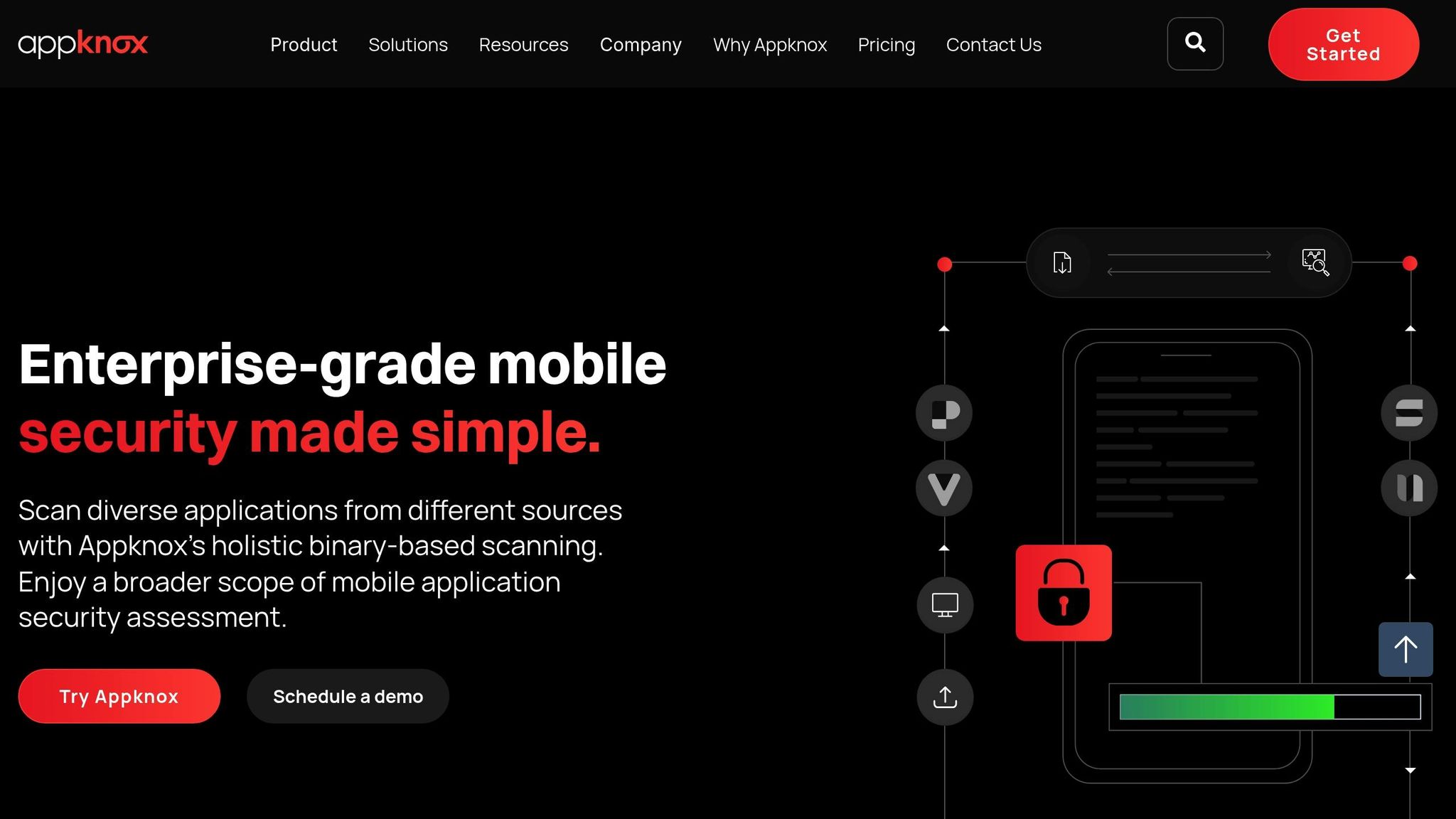
Appknox is a powerful tool designed to automate vulnerability assessments for mobile apps, covering both Android and iOS platforms. By analyzing app binaries, it generates a detailed Software Bill of Materials (SBOM) that lists frameworks, libraries, components, and licenses, while flagging outdated versions and uncovering hidden vulnerabilities.
Binary Analysis and SBOM
Appknox employs a binary-based approach to analyze your app's files and libraries, eliminating the need for source code access. This method allows it to produce an in-depth SBOM, cataloging all frameworks, libraries, components, and code licenses within your app. It excels at pinpointing outdated dependencies and identifying vulnerabilities within your app's entire supply chain. Additionally, its automation features make it seamless to integrate into modern development workflows.
Automation and CI/CD Integration
With automation at its core, Appknox delivers detailed security reports in less than 60 minutes and boasts an impressive <1% false positive rate. This accuracy helps reduce the unnecessary alerts that often slow down development teams.
"Appknox makes DevSecOps adoption effortless by integrating security automation into existing CI/CD pipelines."
The platform integrates smoothly with popular CI/CD tools like GitHub, Bitrise, GitLab CI/CD, Jenkins, and Azure. It offers CLI and public API support, allowing teams to customize security automation to fit their workflows.
Vulnerability Coverage (Including OWASP Mobile Top 10)
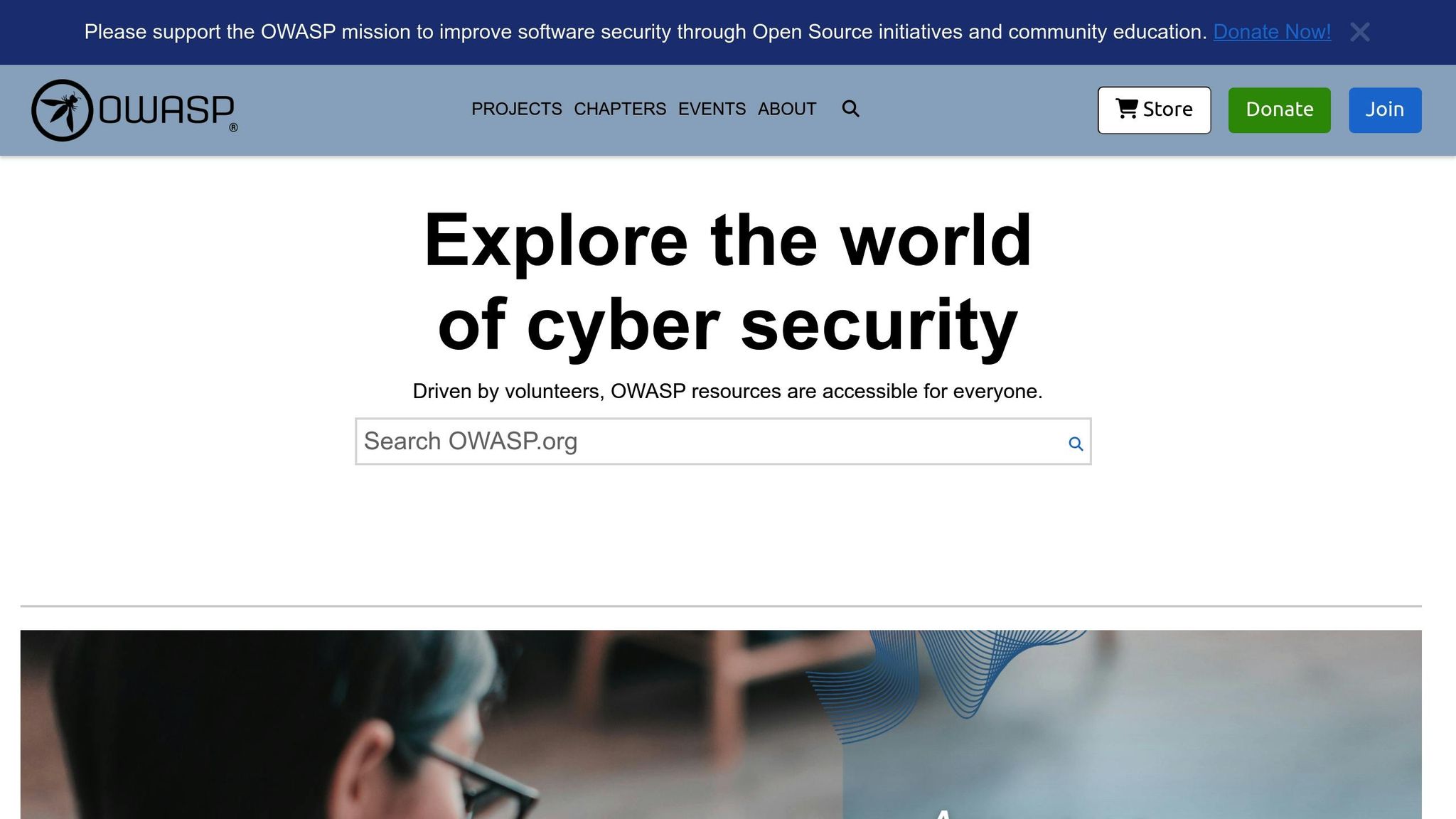
Appknox provides detailed CVSS reports that address vulnerabilities outlined in the OWASP Mobile Top 10 list. Each report includes actionable steps for remediation. Its test cases align with the latest OWASP guidelines for mobile app security, ensuring adherence to current industry standards.
What sets Appknox apart is its binary-based SBOM solution, which digs deep into your app's ecosystem. This approach identifies vulnerabilities hidden in third-party libraries or outdated frameworks, addressing the complex web of dependencies common in modern mobile app development.
Support for Both Android and iOS
Appknox simplifies security testing for teams managing apps across multiple platforms. Its binary analysis works seamlessly for both Android and iOS, eliminating the need for separate tools or configurations. This unified approach streamlines workflows, making it easier to maintain security across diverse mobile app portfolios.
2. MobSF (Mobile Security Framework)
MobSF is an open-source framework designed for mobile security testing, offering both static and dynamic analysis for mobile apps. While it's free to use, MobSF comes with certain limitations that may affect its usefulness in practical scenarios.
Real-Device Testing Capability
MobSF's dynamic tests are restricted to emulators, with no support for real-device testing on Android or iOS. This means it can't fully simulate real-world conditions like sensor interactions, battery usage, or network instability. Moreover, many mobile apps are built to detect emulator environments and might behave differently, potentially hiding vulnerabilities during testing.
"No, it doesn't. MobSF's dynamic tests run only on emulators. Real-device DAST (offered by advanced solutions like Appknox) catches runtime vulnerabilities, environment-specific bugs, and anti-emulation evasion techniques that emulators miss. These are crucial for apps running in diverse and regulated production environments." – Appknox
This limitation highlights the importance of real-device testing. Without it, critical runtime vulnerabilities and environment-specific issues in live applications may go unnoticed.
Automation and CI/CD Integration
MobSF does offer basic automation options through its CLI and REST API. However, integrating it into CI/CD pipelines often requires manual configuration, making it less streamlined compared to enterprise solutions.
Vulnerability Coverage (Including OWASP Mobile Top 10)
MobSF's static analysis engine is effective in identifying vulnerabilities, including those outlined in the OWASP Mobile Top 10. It detects issues like insecure data storage, weak cryptography, insecure communication, and authentication flaws. Additionally, its reports provide severity ratings and remediation guidance, helping developers address code-level problems, hardcoded secrets, and insecure APIs.
Support for Both Android and iOS
MobSF supports security testing for Android APKs and iOS IPAs. While its static analysis for Android apps is thorough, its ability to perform advanced iOS-specific checks may lag behind some commercial tools.
| Feature | MobSF (open source) | Enterprise Solutions |
|---|---|---|
| Real-device testing | ❌ No | ✅ Yes |
| CI/CD integration | Basic (CLI/manual) | ✅ Automatic scans on build |
| Scan speed | Good for samples | ✅ Scalable and optimized for apps |
| SBOM / dependency tracking | Manual/SAST | ✅ Automated SBOM with alerts |
| Collaboration & workflows | Local reports | ✅ Team dashboards, issue tracking |
| False-positive tuning | Manual review needed | ✅ Tuned low noise by design |
3. eShard (esReverse)

eShard's esReverse is a reverse engineering tool designed for detailed mobile app analysis. Unlike standard DAST tools, esReverse combines dynamic analysis with advanced reverse engineering techniques, making it a go-to choice for comprehensive security assessments. Here's a closer look at how esReverse addresses key mobile app security needs.
Real-Device Testing Capability
esReverse offers real-device testing for both Android and iOS platforms, which allows it to analyze apps on actual hardware rather than relying on emulators. This is crucial for uncovering runtime behaviors, such as anti-debugging techniques and vulnerabilities tied to specific devices or hardware-dependent security flaws.
For deeper analysis, esReverse supports rooted Android devices and jailbroken iOS devices. This capability enables security professionals to identify vulnerabilities that apps might conceal in controlled environments like emulators. It’s an essential feature for researchers and penetration testers aiming to expose system-level weaknesses.
Automation and CI/CD Integration
While esReverse shines in manual analysis and reverse engineering, its automation capabilities are somewhat limited compared to enterprise-grade solutions. The tool is tailored for hands-on work by security professionals rather than fully automated CI/CD pipeline integration.
It does include scripting capabilities, which allow more experienced users to automate specific tasks. However, integrating esReverse into automated workflows requires significant manual setup and expertise. This makes it better suited for dedicated security teams performing thorough investigations rather than development teams seeking seamless, automated security testing. Its focus on manual analysis sets it apart from tools that prioritize automated vulnerability scanning.
Vulnerability Coverage (Including OWASP Mobile Top 10)
esReverse is particularly effective at detecting OWASP Mobile Top 10 vulnerabilities, thanks to its robust reverse engineering capabilities. The platform can identify issues like insecure data storage, weak cryptography, and improper platform usage by providing deep insights into app behavior and code execution.
Its strength lies in uncovering complex attack vectors that automated tools often miss. For example, it can analyze custom encryption methods, proprietary security features, and intricate business logic flaws. This makes esReverse a valuable tool for assessing high-value targets or apps with unique security designs.
Support for Both Android and iOS
The platform provides comprehensive support for Android and iOS, with specialized modules for each operating system. For Android, esReverse can analyze APK files, DEX bytecode, and native libraries, offering detailed insights into app behavior, API interactions, and system-level operations.
On the iOS side, it works with IPA files and Mach-O binaries, delivering robust analysis on jailbroken devices. It supports the examination of Objective-C and Swift code, evaluates framework usage, and investigates iOS-specific security features like keychain access and app sandboxing.
| Analysis Aspect | esReverse Capability | Best Use Case |
|---|---|---|
| Reverse Engineering | Advanced decompilation and code analysis | Security research and threat modeling |
| Real-Device Testing | Supports rooted/jailbroken devices | Detecting anti-emulation and hardware issues |
| Automation Level | Manual with scripting options | In-depth security assessments |
| Learning Curve | Steep - requires security expertise | Dedicated security teams and researchers |
4. Checkmarx DAST
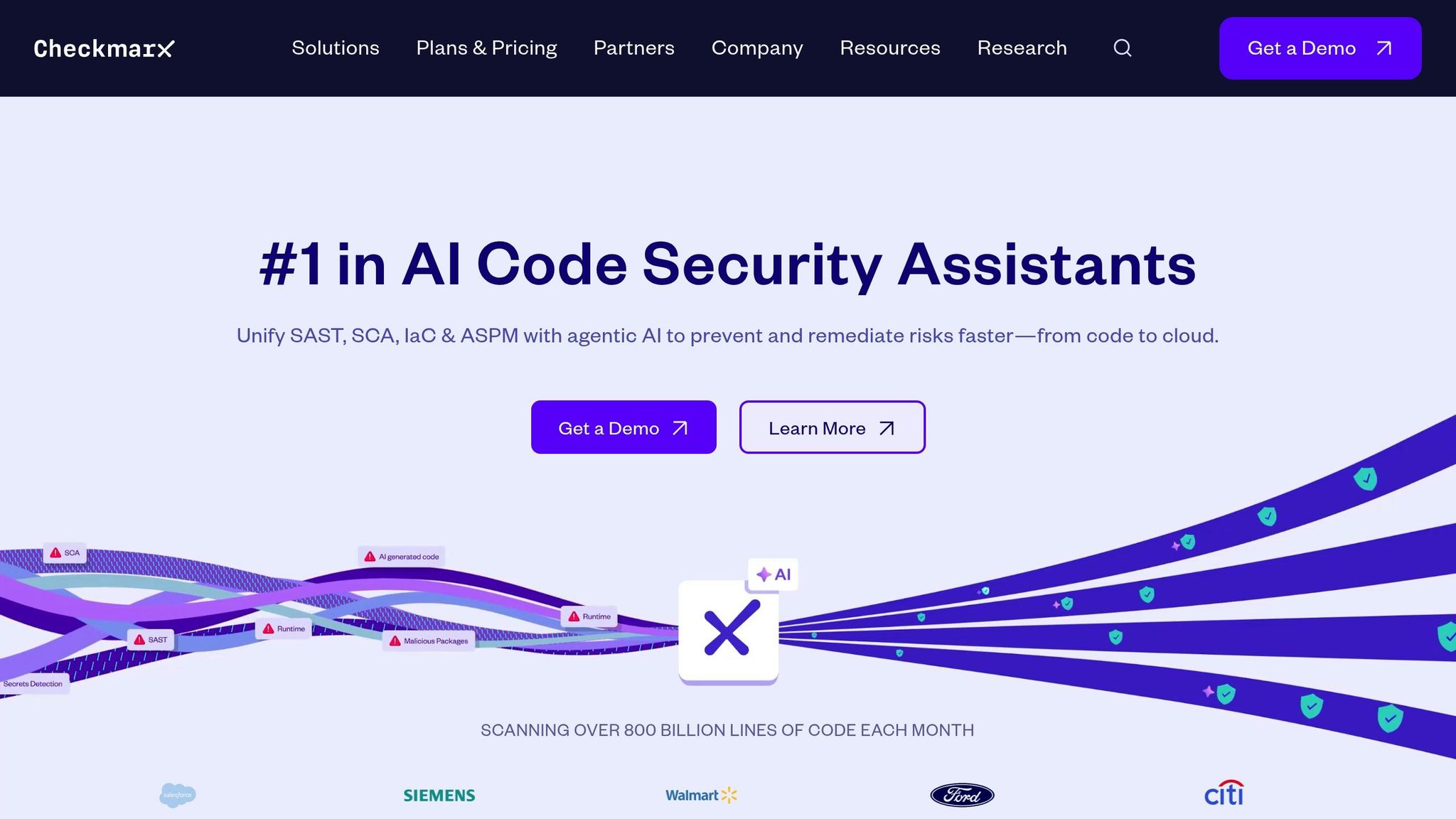
Checkmarx DAST is a robust security tool designed for enterprise-level web testing. However, it falls short when it comes to mobile platform support, particularly for iOS.
Automation and CI/CD Integration
This platform integrates smoothly into CI/CD pipelines, making it easy to automate scans during both development and pre-production stages. With its API global inventory feature, security teams can centralize and monitor API vulnerabilities across various projects, providing a clear picture of the organization's API security landscape.
Despite these strengths, its capabilities for mobile platforms leave room for improvement.
Support for Both Android and iOS
When it comes to mobile platforms, Checkmarx DAST offers only basic support. For iOS, the lack of proper Swift compatibility is a significant drawback, limiting its effectiveness in testing native iOS applications. While it does support mobile testing for web APIs and some functionalities, its focus remains heavily skewed toward web applications. This creates a noticeable gap compared to tools that cater specifically to native mobile security testing.
Vulnerability Coverage (Including OWASP Mobile Top 10)
Checkmarx DAST excels in identifying vulnerabilities in web-based components of mobile applications, such as web APIs or web views. However, its ability to detect native mobile app vulnerabilities is limited. For example, it struggles with identifying issues like improper platform usage, insecure data storage, and mobile-specific cryptographic flaws - key concerns outlined in the OWASP Mobile Top 10.
| Testing Focus | Checkmarx DAST Strength | Mobile App Limitation |
|---|---|---|
| Web APIs | Comprehensive scanning and inventory | Limited native mobile context |
| iOS Applications | Basic functionality | Inadequate Swift support |
| CI/CD Integration | Excellent automation capabilities | Mobile-specific workflows need improvement |
| Enterprise Features | Strong reporting and management | Mobile security metrics less detailed |
sbb-itb-8abf120
5. Jit
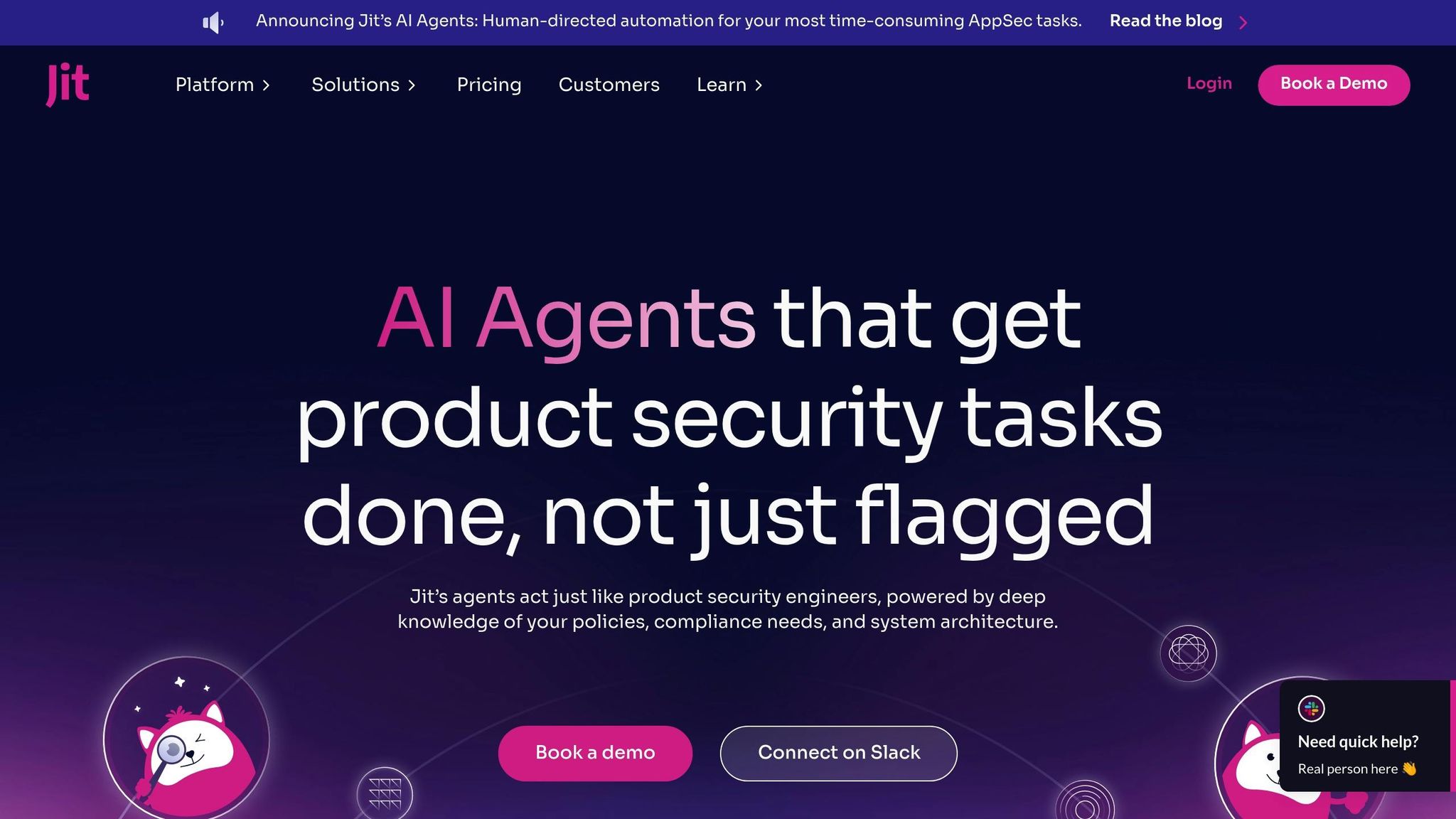
Jit is designed specifically for automated security testing of web applications and APIs, which makes it a poor fit for developers seeking robust mobile security solutions. Let’s break down how Jit’s focus on web security creates a clear divide when compared to its lack of mobile testing capabilities.
Automation and CI/CD Integration
Jit shines when it comes to automating security workflows for web applications. It simplifies the process by automating the configuration, deployment, and management of OWASP ZAP for dynamic testing of web apps and APIs. This level of automation makes it easy to integrate security checks into development pipelines without requiring manual effort. However, its functionality is strictly limited to web applications - native mobile platforms are left out entirely.
Support for Android and iOS
When it comes to mobile platforms like Android and iOS, Jit falls short. It doesn’t provide dedicated DAST (Dynamic Application Security Testing) support for these environments. Its features are tailored exclusively to web applications, leaving a critical gap for developers who need to secure native mobile apps and address their unique vulnerabilities.
Vulnerability Coverage (Including OWASP Mobile Top 10)
Jit’s vulnerability detection capabilities are optimized for web environments only. While it’s effective at identifying common web-related vulnerabilities, it doesn’t address mobile-specific issues, such as those highlighted in the OWASP Mobile Top 10. This makes it unsuitable for teams focused on securing mobile applications.
Here’s a quick comparison of Jit’s capabilities against mobile app security needs:
| Testing Capability | Jit's Coverage | Mobile App Relevance |
|---|---|---|
| Web API Security | Comprehensive automated scanning | Limited to API endpoints only |
| Native Mobile Apps | No dedicated support | Major gap for mobile developers |
| OWASP Mobile Top 10 | Not applicable | Misses critical mobile vulnerabilities |
| Platform Integration | Excellent for web CI/CD | Insufficient for mobile development needs |
For teams working exclusively on web applications, Jit’s automation and seamless integration into CI/CD pipelines are strong points. However, for developers prioritizing mobile app security, Jit’s web-focused approach leaves much to be desired. Its lack of native mobile testing capabilities makes it ill-suited for addressing mobile-specific security challenges.
6. StackHawk
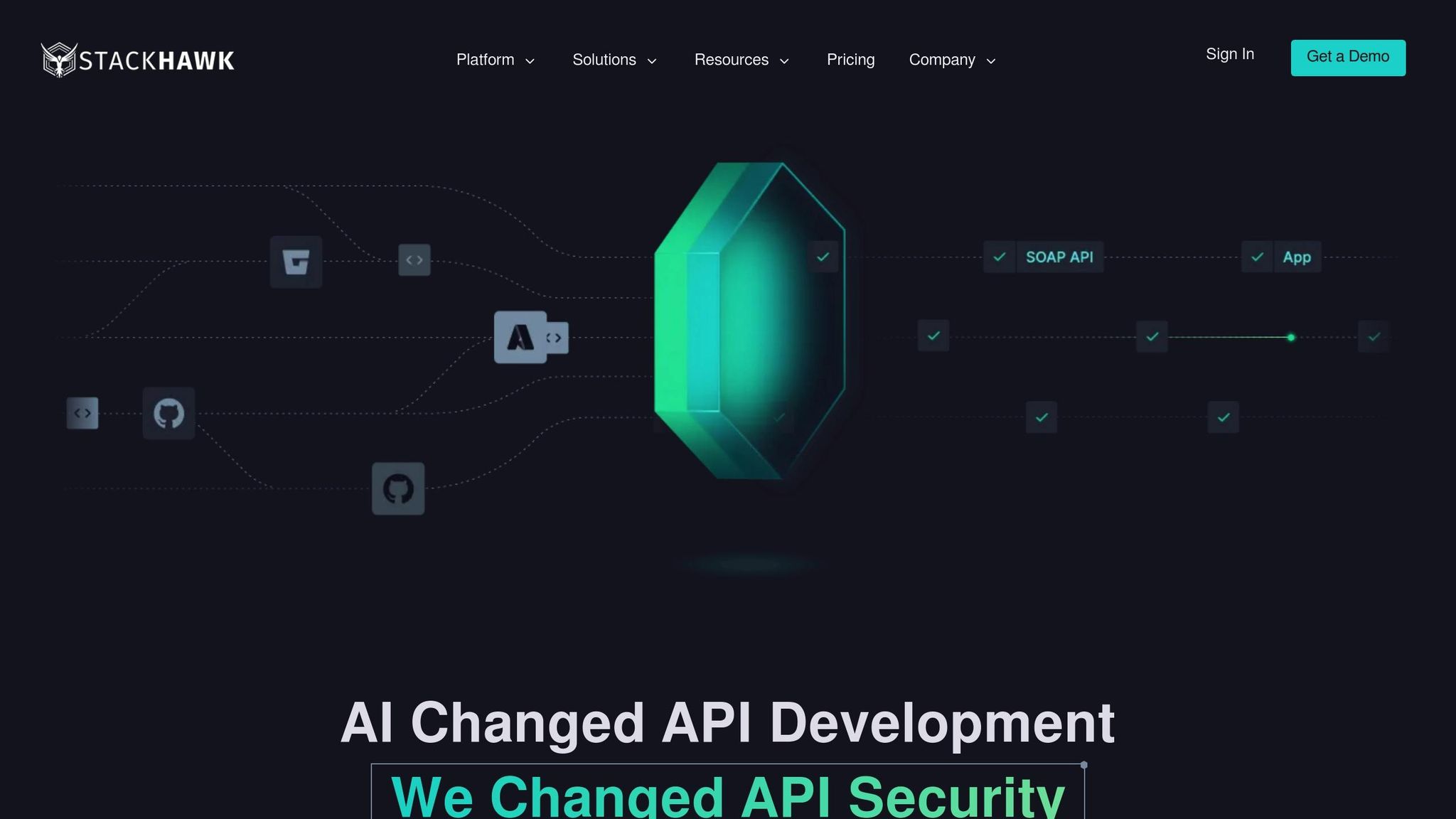
StackHawk is a developer-focused platform designed to address web and API security. However, it does not provide extensive support for native mobile testing. While its strengths lie in automation and integration with CI/CD pipelines, it lacks the tools necessary for testing vulnerabilities specific to mobile applications. Let’s break down how its features stack up.
Automation and CI/CD Integration
StackHawk integrates effortlessly with CI/CD workflows, running HawkScan on every pull request to quickly identify new vulnerabilities. It also analyzes source code repositories to locate APIs automatically. This level of automation is highly effective for web applications, ensuring vulnerabilities are caught early in the development cycle. However, mobile app testing often requires unique deployment methods and testing strategies that StackHawk does not currently address.
Vulnerability Coverage (Including OWASP Mobile Top 10)
The platform is adept at identifying OWASP Top 10 vulnerabilities across web environments like HTML, single-page applications (SPAs), REST APIs, and GraphQL. However, it doesn’t extend its detection capabilities to mobile-specific vulnerabilities, such as those outlined in the OWASP Mobile Top 10. This gap limits its utility for teams working on native mobile applications.
Support for Both Android and iOS
StackHawk’s focus remains firmly on web and API security, offering no dedicated tools for native Android or iOS app testing. Instead, it prioritizes securing APIs and web technologies, which are often consumed by mobile apps, but does not address the unique security needs of mobile platforms.
| Testing Focus | StackHawk's Strength | Mobile App Limitation |
|---|---|---|
| Web Applications | Comprehensive DAST scanning | No native mobile app support |
| API Security | Effective REST and GraphQL testing | Limited to API endpoints |
| CI/CD Integration | Seamless developer workflow | Web-focused automation only |
| Platform Coverage | Strong web technology support | Lacks native Android/iOS testing |
For development teams focused on web applications and API security, StackHawk offers robust automation and integration features. However, teams requiring full-scale mobile app security testing will need to look elsewhere for tools specifically tailored to native mobile platforms. Next, we’ll dive into how Detectify approaches mobile app security.
7. Detectify
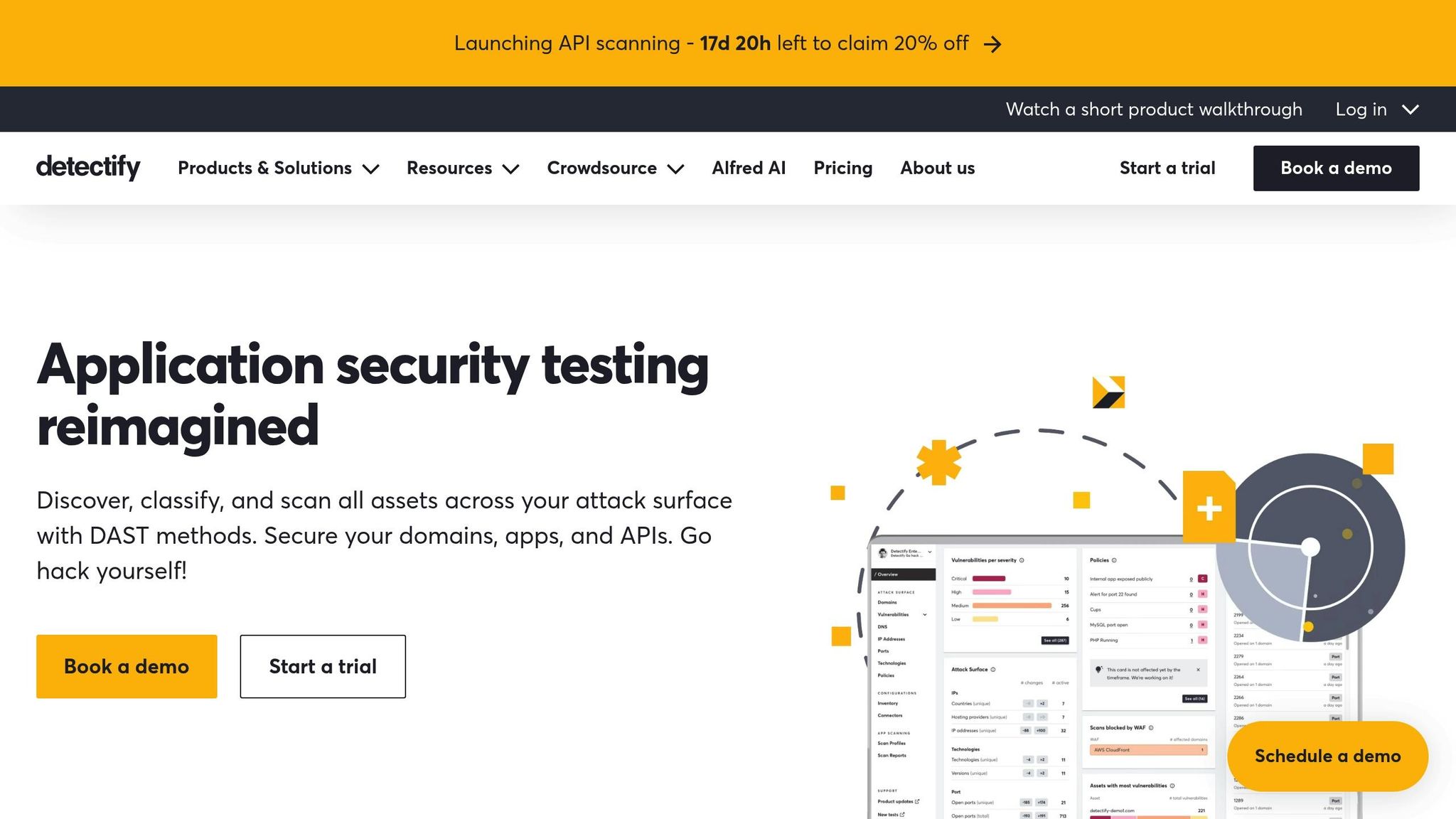
Detectify is well-known for its web security scanning capabilities, but it does not offer dedicated support for mobile DAST (Dynamic Application Security Testing) on Android or iOS. This limitation highlights the growing importance of specialized mobile DAST solutions as we head into 2025.
Approach to Vulnerability Assessment
Detectify relies on automated scanning to uncover common web vulnerabilities. However, there's no clear indication that it addresses risks specific to mobile applications. Developers working on mobile platforms should carefully assess whether Detectify aligns with their security needs.
Integration and Automation
On the integration front, Detectify provides automated scheduled scans and supports API integration for web workflows. That said, its ability to test mobile binaries, such as APK or IPA files, hasn't been demonstrated. Unlike tools specifically designed for mobile DAST, Detectify's primary focus on web security leaves a noticeable gap when it comes to detecting vulnerabilities in mobile environments. Mobile development teams should consider tools that are proven to offer comprehensive mobile DAST capabilities.
While Detectify is a strong choice for organizations prioritizing web security, mobile development teams should explore additional solutions tailored to address the unique challenges of mobile application security.
Feature Comparison Table
Here's a quick breakdown of how each tool stacks up in terms of supported platforms, pricing, strengths, and limitations based on our evaluation criteria:
| Tool | Supported Platforms | Pricing Model | Key Strengths | Main Limitations |
|---|---|---|---|---|
| Appknox | Android, iOS, React Native, Flutter, APIs | Custom, usage-based | Real-device testing, under 1% false positives, user-friendly dashboards | Requires custom pricing discussions |
| MobSF | Android, iOS, Windows apps | Free, open-source | Detailed static and dynamic analysis, no licensing costs | Steep learning curve, limited enterprise support |
| eShard (esReverse) | Mobile apps, websites, web applications | Custom pricing | Advanced binary analysis, emulation capabilities | Focused mainly on binary analysis |
| Checkmarx DAST | Web applications, APIs, cloud-native | Custom, higher for full features | Unified reporting, CI/CD integration | Complex interface; less mobile-focused |
| Jit | APIs, web applications | Free trial available | Easy deployment, automated scanning, real-time detection | Limited customization for advanced use cases |
| StackHawk | Applications, APIs (REST, GraphQL, SOAP, gRPC) | Scalable plans, free trial | Developer-friendly interface, automated API discovery | Requires manual API schema uploads |
| Detectify | Web applications, public-facing apps | Commercial | Quick setup, strong CI integration | Geared toward public-facing web apps; lacks mobile support |
If you're on a tight budget, MobSF stands out as the only free option, though it requires time and effort to configure and learn. For startups or growing teams, StackHawk offers flexible pricing plans, while tools like Appknox, eShard, and Checkmarx involve custom pricing discussions.
The tools differ in focus. For example, Appknox excels in mobile-first testing with support for Android, iOS, React Native, and Flutter, offering real-device testing capabilities. Meanwhile, Checkmarx DAST and Detectify are more web-focused, targeting web applications over mobile environments.
Developer-friendly design is a key strength for tools like Appknox and StackHawk, both of which integrate smoothly into CI/CD pipelines. Jit, on the other hand, prioritizes straightforward deployment with robust detection and reporting features. Notably, Appknox achieves less than 1% false positives, saving developers significant time by minimizing unnecessary investigations. However, some tools lack robust risk prioritization in their analytics, which could affect efficiency.
This comparison highlights the strengths and trade-offs of each tool, helping you identify the best fit for your mobile security needs. Whether you’re prioritizing platform coverage, pricing flexibility, or ease of use, there’s a solution tailored to your requirements.
Conclusion
Choosing the best DAST tool for your mobile app development team requires careful consideration of your specific needs. Factors like your organization's goals, the complexity of your app, and how easily the tool integrates into your workflow are key. For instance, Appknox supports both native Android and iOS apps as well as cross-platform frameworks, making it a versatile choice for diverse development environments. Evaluating these factors upfront helps clarify priorities like budget, integration, and technical expertise.
Speaking of budgets, they matter a lot. If you're working with limited resources, MobSF offers a cost-effective solution, though it may require more effort to set up. For organizations expecting to scale, StackHawk provides flexible pricing plans that can grow alongside your security needs.
Integration is another critical piece of the puzzle. Tools that easily fit into your CI/CD pipeline, like Appknox and StackHawk, ensure that security testing doesn’t slow your team down. Their user-friendly interfaces can also save valuable time during setup and ongoing use.
It’s also crucial to test early and often. Regular security checks help catch vulnerabilities when they’re easier - and cheaper - to fix. Plus, tools with low false positive rates save your developers time, which becomes even more important as your app portfolio expands.
Finally, as mobile security threats continue to change, it’s important to pick tools that stay updated. Whether you need strong support for mobile platforms, API testing, or binary analysis, the right DAST tool will enhance your security without disrupting your workflow. This evaluation aims to guide you in finding a tool that meets both your current and future development needs.
FAQs
What should you look for in a DAST tool to secure mobile apps in 2025?
When choosing a Dynamic Application Security Testing (DAST) tool for mobile apps in 2025, it's important to prioritize features that align with the demands of modern app development. Look for tools that offer seamless integration with your CI/CD workflows, ensuring they fit smoothly into your existing processes. The ability to identify vulnerabilities with high precision is crucial, along with support for APIs and compatibility across multiple platforms. A tool that's intuitive for both developers and security teams can make all the difference.
In today's fast-paced development cycles, automation and real-time feedback are non-negotiable. The right DAST tool should simplify manual tasks, adjust to the specific needs of your app, and enhance your security measures - all without putting the brakes on your development speed.
Why is real-device testing more effective than emulator-based testing for mobile app security?
Real-device testing stands out as a more reliable approach because it mirrors actual conditions users experience. It uncovers hardware-specific vulnerabilities, real network behaviors, and authentic user interactions - elements that emulators frequently fail to capture. While emulators are useful for simulating environments, they often miss critical security flaws tied to physical hardware, such as hardware-backed security features or device-specific quirks. This makes testing on real devices a crucial step for thorough mobile app security evaluations.
Why is it important for a DAST tool to minimize false positives, and how does this benefit development teams?
Minimizing false positives in Dynamic Application Security Testing (DAST) tools is crucial for keeping development teams focused on addressing real vulnerabilities rather than chasing non-existent issues. When a tool generates too many false positives, it can lead to frustration, erode trust in its accuracy, and slow down the process of tackling genuine security threats.
A DAST tool with a low rate of false positives helps teams work more efficiently by cutting down on unnecessary distractions. It reduces alert fatigue, allowing developers to concentrate on critical fixes. This not only strengthens the security of the application but also boosts the team's productivity and confidence in their workflow.




.avif)
